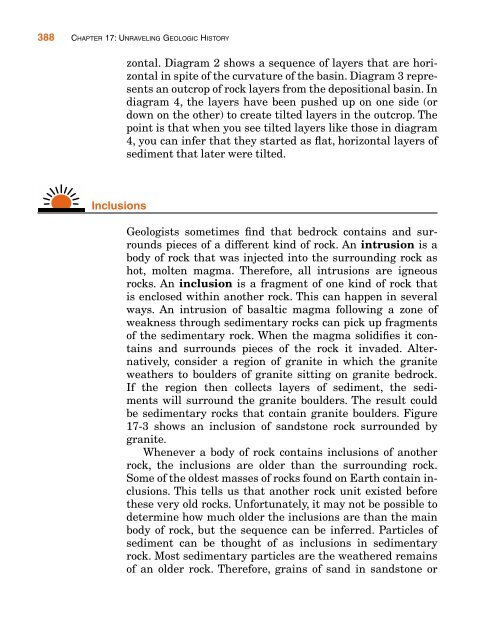Chapter 17 Unraveling Geologic History
Chapter 17 Unraveling Geologic History
Chapter 17 Unraveling Geologic History
Create successful ePaper yourself
Turn your PDF publications into a flip-book with our unique Google optimized e-Paper software.
388 CHAPTER <strong>17</strong>: UNRAVELING GEOLOGIC HISTORY<br />
Inclusions<br />
zontal. Diagram 2 shows a sequence of layers that are horizontal<br />
in spite of the curvature of the basin. Diagram 3 represents<br />
an outcrop of rock layers from the depositional basin. In<br />
diagram 4, the layers have been pushed up on one side (or<br />
down on the other) to create tilted layers in the outcrop. The<br />
point is that when you see tilted layers like those in diagram<br />
4, you can infer that they started as flat, horizontal layers of<br />
sediment that later were tilted.<br />
Geologists sometimes find that bedrock contains and surrounds<br />
pieces of a different kind of rock. An intrusion is a<br />
body of rock that was injected into the surrounding rock as<br />
hot, molten magma. Therefore, all intrusions are igneous<br />
rocks. An inclusion is a fragment of one kind of rock that<br />
is enclosed within another rock. This can happen in several<br />
ways. An intrusion of basaltic magma following a zone of<br />
weakness through sedimentary rocks can pick up fragments<br />
of the sedimentary rock. When the magma solidifies it contains<br />
and surrounds pieces of the rock it invaded. Alternatively,<br />
consider a region of granite in which the granite<br />
weathers to boulders of granite sitting on granite bedrock.<br />
If the region then collects layers of sediment, the sediments<br />
will surround the granite boulders. The result could<br />
be sedimentary rocks that contain granite boulders. Figure<br />
<strong>17</strong>-3 shows an inclusion of sandstone rock surrounded by<br />
granite.<br />
Whenever a body of rock contains inclusions of another<br />
rock, the inclusions are older than the surrounding rock.<br />
Some of the oldest masses of rocks found on Earth contain inclusions.<br />
This tells us that another rock unit existed before<br />
these very old rocks. Unfortunately, it may not be possible to<br />
determine how much older the inclusions are than the main<br />
body of rock, but the sequence can be inferred. Particles of<br />
sediment can be thought of as inclusions in sedimentary<br />
rock. Most sedimentary particles are the weathered remains<br />
of an older rock. Therefore, grains of sand in sandstone or
















